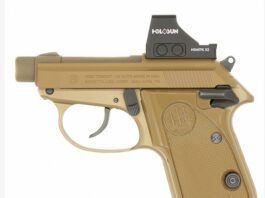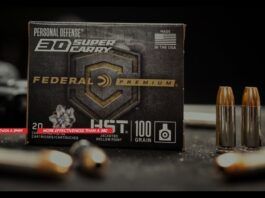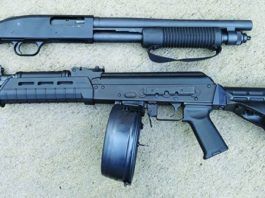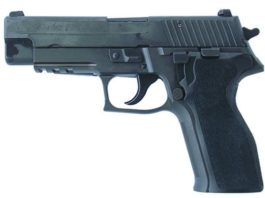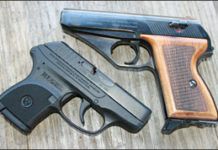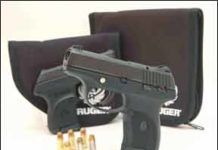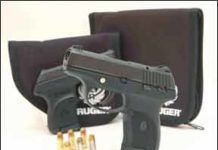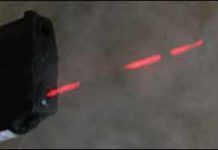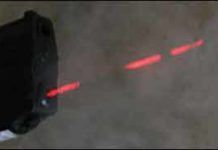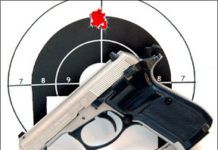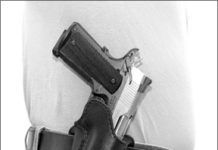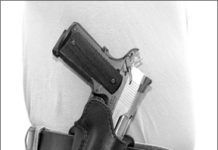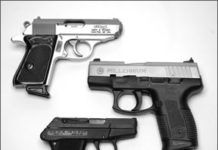22 Mag and 32 Mag Loads: Are They Enough for Self-Defense?
A common thread among old-time shooters is the deadly effect of the 22 Winchester Magnum Rimfire cartridge. Long recommended as a woman’s cartridge, the WMR...
Old Against New Pocket Pistol Duel: Mauser HSc vs. Ruger LCP
Pocket pistols chambered in 380 ACP may seem like a recent trend, but the 380 cartridge has been around since 1908. During WWII, Colt, Walther, Mauser, Beretta, Sauer and others built small, compact pistols for this round. There are numerous examples of these old-school pistols still available. The HSc was Mausers attempt at building an inexpensive pistol in 1936. It was the first time Mauser used stamped steel in its pistol designs, and the handgun was originally made for the commercial market. But during WWII, the German military purchased more than 160,000 HSc pistols, mostly for the countrys army and naval forces. The HSc was produced and imported through 1977, and online and in used gun-shop cases, you can still find these sleek pistols. And they can be had for a song. So we wondered, if we had our druthers, would we chose an old-school HSc with its pedigree or would we prefer a contemporary pocket pistol such as the Ruger LCP, a more recent and contemporary design thats actually a knock-off of the Kel-Tec P-3AT pistol?Though these pistols may seem at opposite ends of the spectrum for self-defense use, they were both designed for ease of manufacture, consistent reliability, and the ability to be easily concealed. Our testers compared the two pistols on cost, utility, and concealability. Here is what they found:
S&W Bodyguards: Revolver Or Semiauto for Self Defense?
In this report we look at S&Ws two so-called Bodyguards, one a revolver in 38 Special, the other a semiautomatic pistol in 380 ACP. Both were fitted with adjustable laser sights. The first thing we found was the lasers are useless outdoors in bright daylight, no matter what youve been led to believe by various TV shows. On an overcast day, the lasers on these two pistols might be of some value, but we much prefer to use iron sights when we can see em. With them, theres nothing to turn on, no buttons to push.If you like the idea of using a laser indoors at night, these setups might be okay for you. Weve said before we dont like giving our location away by the glow of a laser sight to anyone who might be in our house whos not supposed to be there. However, a good laser - and these seem to be excellent - is a reasonable aiming device in conditions when you just cant see your iron sights and dont - or cant - have tritium inserts. Both of these handguns have adjustments so you can put the laser dots right at the impact point of your chosen ammo. One push of a button turns on the laser. A second push puts the laser into a pulsing mode, and a third turns it off, same for both guns, though they have different button setups. We shot with the ammo available, which for the 38 Special was one handload with 158-grain lead SWC and some CCI Blazer 125-grain JHP. For the 380 we used brass-case CCI Blazer with 95-grain FMJ bullets. Heres what we found.
Ruger LC380 ACP Pistol: Downsized Nine That Works
Being a magazine that deals primarily with the testing and evaluation of firearms and accessories, were always looking for the next big thing. Not long ago the next big thing was the small concealment pistol chambered for 380 Auto. One such pistol was the Ruger LCP380, and it seemed like every maker was bringing out a small pistol with barrel lengths shorter than 3 inches and an overall size that could fit inside the dimensions of the average adults hand.One of the things that worked against these guns was the lack of availability of ammunition. Call it 9mm Browning, 9mm Corto, 9mm Kurz - in English, 9mm Short - 380 ACP ammunition was difficult to find. Another factor that seemed to cool enthusiasm for the little 380s was handling and recoil. While 380 Auto is not a big banger, when housed in a smaller package with limited grip space, every impulse was magnified. In addition, a lot of buyers have found these smaller guns with their necessarily taut recoil springs to be unappealing simply because they have trouble manipulating the slide.In the meantime, Ruger introduced a new pistol of similar design to the LCP, but slightly bigger, chambered for 9mm Luger, 9x19 or 9mm Parabellum, or regular-sized 9mm ammunition. This pistol was a lot easier to hold and work than the still-smaller 380 pocket guns, but the bigger powder payload also offered additional recoil. Solution: For 2013, Ruger introduced the LC9 re-chambered for 380 Auto, which addresses both the desire for less recoil and easier handling, and we were able to land one for evaluation. So that we could hurry the test into print, we didnt try to match it up against other 9mms, but rather relied on previous test notes to put the little Ruger into perspective.
S&W Bodyguards: Revolver Or Semiauto for Self Defense?
In this report we look at S&Ws two so-called Bodyguards, one a revolver in 38 Special, the other a semiautomatic pistol in 380 ACP. Both were fitted with adjustable laser sights. The first thing we found was the lasers are useless outdoors in bright daylight, no matter what youve been led to believe by various TV shows. On an overcast day, the lasers on these two pistols might be of some value, but we much prefer to use iron sights when we can see em. With them, theres nothing to turn on, no buttons to push.If you like the idea of using a laser indoors at night, these setups might be okay for you. Weve said before we dont like giving our location away by the glow of a laser sight to anyone who might be in our house whos not supposed to be there. However, a good laser - and these seem to be excellent - is a reasonable aiming device in conditions when you just cant see your iron sights and dont - or cant - have tritium inserts. Both of these handguns have adjustments so you can put the laser dots right at the impact point of your chosen ammo. One push of a button turns on the laser. A second push puts the laser into a pulsing mode, and a third turns it off, same for both guns, though they have different button setups. We shot with the ammo available, which for the 38 Special was one handload with 158-grain lead SWC and some CCI Blazer 125-grain JHP. For the 380 we used brass-case CCI Blazer with 95-grain FMJ bullets. Heres what we found.
Ruger LC380 ACP Pistol: Downsized Nine That Works
Being a magazine that deals primarily with the testing and evaluation of firearms and accessories, were always looking for the next big thing. Not long ago the next big thing was the small concealment pistol chambered for 380 Auto. One such pistol was the Ruger LCP380, and it seemed like every maker was bringing out a small pistol with barrel lengths shorter than 3 inches and an overall size that could fit inside the dimensions of the average adults hand.One of the things that worked against these guns was the lack of availability of ammunition. Call it 9mm Browning, 9mm Corto, 9mm Kurz - in English, 9mm Short - 380 ACP ammunition was difficult to find. Another factor that seemed to cool enthusiasm for the little 380s was handling and recoil. While 380 Auto is not a big banger, when housed in a smaller package with limited grip space, every impulse was magnified. In addition, a lot of buyers have found these smaller guns with their necessarily taut recoil springs to be unappealing simply because they have trouble manipulating the slide.In the meantime, Ruger introduced a new pistol of similar design to the LCP, but slightly bigger, chambered for 9mm Luger, 9x19 or 9mm Parabellum, or regular-sized 9mm ammunition. This pistol was a lot easier to hold and work than the still-smaller 380 pocket guns, but the bigger powder payload also offered additional recoil. Solution: For 2013, Ruger introduced the LC9 re-chambered for 380 Auto, which addresses both the desire for less recoil and easier handling, and we were able to land one for evaluation. So that we could hurry the test into print, we didnt try to match it up against other 9mms, but rather relied on previous test notes to put the little Ruger into perspective.
Pocket Pistols with Factory Lasers: Walther, SIG, and Ruger
Lasersights on handguns are common today. Scan the used-handgun case at a gun shop, and more than likely youll find a rig that the former owner customized with a laser sight. In the new-pistol case, you will also see factory-fitted laser sights on handguns. We were interested in how factory-fitted lasersights would affect our judgment of three previously tested 380 ACP pistols, the Ruger LCP, SIGs P238, and Walthers PK380. The Ruger earned an A- grade in the June 2008, and the SIG notched an A- in the June 2010 issue, and the Walther got a B-, also in the June 2010 issue. The lasered versions of those handguns are the Ruger LCP-LM No. 3718 380 ACP, $443; SIG Sauers P238 Tactical Laser No. 238-380-TL 380 ACP, $829; and Walthers PK380 With Laser No. WAP40010 380 ACP, $489. Would the addition of a laser sight change our mind about the pistol? Would the addition of a laser bulk up a pocket pistol with a gadget? Would the laser be an asset or a detriment to an already fine pistol? The three pistols spanned the spectrum of action types.The Ruger is a DAO (Double Action Only). The Walther PK380 is a traditional DA/SA (Double Action/Single Action) pistol, where the pistol can be fired DA and subsequently fired SA. The SIG, SA only, was set up like a mini 1911. These pistols are made for close work, so we tested for accuracy at 15 yards with open sights, but were more interested in using the lasers in unconventional shooting positions, much like you might encounter in a real-life confrontation with a bad actor. Our goal with these lasered pocket pistols was to quickly project the red dot on target and punch holes in targets efficiently and effectively. We used D-1 tombstone-style targets with a 4-inch-diameter X-ring and an A-ring and B-ring at 8 inches and 12 inches, respectively. The rings are visible at close range - about 5 yards, but beyond that and depending on your eye sight, the rings are undetectable.All three employed red Class IIIa lasers. The warning label was blatantly affixed to each laser. Dont point the laser beam in eyes, as permanent eye damage can result. (Never mind the damage from a 380 slug.) Laser beams can reflect off certain surfaces like TV screens, mirrors, glass, etc. Make sure you test the laser of an unloaded weapon so you can experience how the laser beam can react. Also note that laser sights should also be removed when cleaning the weapon, as oils and solvents are not good for the lasers electronics.As in any test, we focused on the major areas of importance with these pistols, such as reliability, concealability, shooter comfort, and accuracy. But because of the lasers, we zeroed in on how the optics affected handling, printing, and other carry issues.
Pocket Pistols with Factory Lasers: Walther, SIG, and Ruger
Lasersights on handguns are common today. Scan the used-handgun case at a gun shop, and more than likely youll find a rig that the former owner customized with a laser sight. In the new-pistol case, you will also see factory-fitted laser sights on handguns. We were interested in how factory-fitted lasersights would affect our judgment of three previously tested 380 ACP pistols, the Ruger LCP, SIGs P238, and Walthers PK380. The Ruger earned an A- grade in the June 2008, and the SIG notched an A- in the June 2010 issue, and the Walther got a B-, also in the June 2010 issue. The lasered versions of those handguns are the Ruger LCP-LM No. 3718 380 ACP, $443; SIG Sauers P238 Tactical Laser No. 238-380-TL 380 ACP, $829; and Walthers PK380 With Laser No. WAP40010 380 ACP, $489. Would the addition of a laser sight change our mind about the pistol? Would the addition of a laser bulk up a pocket pistol with a gadget? Would the laser be an asset or a detriment to an already fine pistol? The three pistols spanned the spectrum of action types.The Ruger is a DAO (Double Action Only). The Walther PK380 is a traditional DA/SA (Double Action/Single Action) pistol, where the pistol can be fired DA and subsequently fired SA. The SIG, SA only, was set up like a mini 1911. These pistols are made for close work, so we tested for accuracy at 15 yards with open sights, but were more interested in using the lasers in unconventional shooting positions, much like you might encounter in a real-life confrontation with a bad actor. Our goal with these lasered pocket pistols was to quickly project the red dot on target and punch holes in targets efficiently and effectively. We used D-1 tombstone-style targets with a 4-inch-diameter X-ring and an A-ring and B-ring at 8 inches and 12 inches, respectively. The rings are visible at close range - about 5 yards, but beyond that and depending on your eye sight, the rings are undetectable.All three employed red Class IIIa lasers. The warning label was blatantly affixed to each laser. Dont point the laser beam in eyes, as permanent eye damage can result. (Never mind the damage from a 380 slug.) Laser beams can reflect off certain surfaces like TV screens, mirrors, glass, etc. Make sure you test the laser of an unloaded weapon so you can experience how the laser beam can react. Also note that laser sights should also be removed when cleaning the weapon, as oils and solvents are not good for the lasers electronics.As in any test, we focused on the major areas of importance with these pistols, such as reliability, concealability, shooter comfort, and accuracy. But because of the lasers, we zeroed in on how the optics affected handling, printing, and other carry issues.
380 Pocket Pistols: CZ USA, Sig Sauer, Walther Shoot It Out
One of the hottest trends in firearms sales is the resurgence of pistols chambered for 380 Auto or 9mm Browning. This cartridge is also referred to as 9mm Kurz or 9mm "short." However, scarcity of available ammunition remains a problem. We checked with several retailers and found they were hesitant to sell quantities of 380 ammunition unless the customer was actually buying a 380-caliber handgun. It wasnt until our local gun shop made contact with a wholesaler by the name of Camfour (www.camfour.com) that we were able to locate the necessary quantity of ammunition to complete our tests. But with so many new 380s in the offing, supply of ammunition is bound to catch up.We begin our tests of available 380s with two models that have been in production for so long they are, in regards to marketing, almost invisible. They are the $522 CZ USA Model 83 and the $900 Sig Sauer P232. Our third gun was the $393 Walther PK380. The PK380 has been available for little more than one year. The fourth gun represents the new generation of 380 ACP pistols. The $643 Sig Sauer P238 is a much smaller pistol with little pretense towards filling the role of a primary carry gun.Our test procedure was broken down into two phases of operation. Phase one was to determine base accuracy. We wanted to know what kind of groups could be shot with each gun from sandbag support. Test distance was 15 yards. Our point of aim was the white 1.9-inch circle at the heart of the Reckstine Sight-In Target. This test was performed outdoors.To assess the close-quarter capabilities of each pistol, we utilized a three-shot drill fired at close range upon a Hoffners ABC16 target. Placed 5 yards downrange, we recorded elapsed time beginning with the audible start signal from our Competitive Edge Dynamics electronic shot recording timer (www.cedhk.com). The drill was to fire two shots into the 5.5-inch-wide by 7.9-inch-high A-zone at the center of the humanoid print and then a third shot to the B-zone or cranial pocket. The B-zone was represented by a semi-circle about 5 inches wide and 3 inches high. Start position was with the gun held in both hands pulled in towards the chest with the muzzle raised at approximately a 45-degree angle. We recorded elapsed times for 10 three-shot strings of fire. This test was performed indoors at the newly renovated Top Gun Handgun Training Center in Houston (www.topgunrange.com). Here we benefitted from a state-of-the-art air filtration system and the safety of ballistic partitions, plus a splash-proof backstop. Lighting was adjustable from back-alley dim to classroom bright. We also noticed digital multi-screens behind the counter and behind the scenes in the administrative offices. Not only was unsafe handling quickly addressed by staff, but our vehicles were under constant surveillance as well.Test ammunition consisted of full metal jacket fodder and an innovative defense round from Hornady Manufacturing. Our FMJs were the 92-grain rounds from the Czech Republic by Sellier & Bellot, and 90-grain rounds of PMC Bronze from Korea. To determine carry weight of each gun at full capacity, we weighed each gun (unloaded) with a full magazine plus one round of the 92-grain Sellier and Bellot ammunition. During our break-in session, we fired a variety of rounds, including Hornady XTP hollowpoints. But for recording accuracy data, our third test round was the new 90-grain Hornady Critical Defense ammunition. These rounds, manufactured in Nebraska and sold in boxes of 25, were constructed with a filled hollow point to ensure expansion at any velocity in any media. What struck us was that all four guns ran without a single malfunction. Another aspect was that every round we tried in all four guns, regardless of being offered as target ammunition or for defensive purposes, resulted in about the same amount of felt recoil. Usually, target rounds are softer and defensive rounds leave our hands sore. The test turned out to be a lot of fun. Here is what we learned.
Mixed Bag in Self Defense: Partner Handguns Fight It Out
We recently read The Book of Two Guns, The Martial Art of The 1911 and AR Carbine, by Tiger McKee. McKee is the proprietor and headmaster of the Shootrite Firearms Academy (shootrite.org) located in Langston, Alabama. Printed in long hand with illustrations, McKee instructs and inspires the reader to consider what skills are necessary to effectively use the handgun and rifle weapon interdependently, as well as in transition from one to the other.With the two-gun concept in mind, we decided to go ahead with a story weve been considering for some time-evaluating two pairs of handguns that could also be used to work effectively in tandem, in this case, two revolvers against two pistols.In each pair, we picked one gun that was larger and better suited for primary carry, be it for duty or concealment. The other was significantly smaller and meant to be hidden in case of emergency. Each pair belonged to the same system, or as close as we could supply.For primary carry we chose two 45-caliber weapons, Rugers $836 Redhawk 45 Colt Model KRH454 and Springfield Armorys $785 Mil-Spec Full Size Stainless 1911A1. Paired with the Ruger revolver was the $450 32 H&R Magnum Smith & Wesson Airweight J-frame Model 431PD. To run with the Springfield, we added a $699 9mm Walther PPS semi-automatic, which was light weight and super slim.We could have selected any number of pairs of handguns to fill out our test roster. It is interesting to note that our four guns are each chambered for a different caliber. Certainly when it comes to a primary gun there is more leeway in choice. But when it comes to deep concealment larger calibers demand bigger, stronger and heavier frames. Bigger bullets can also limit capacity. Therefore we felt that system and size was more important than matching caliber.Our test ammunition was as follows. The 45 ACP was represented by Magtech 230-grain FMC, Hornady 185-grain JHP/XTC, and Black Hills 230-grain JHP+P ammunition. The 45 Colt test rounds for the Ruger were Winchester 225-grain Silvertip HP, Federal Champion 225-grain semi-Wadcutter hollowpoints, and Black Hills 250-grain roundnosed flat points. The 9mm ammunition was 125-grain HAP rounds from Atlanta Arms and Ammunition, Black Hills 124-grain full metal jacketed rounds, and Federals 105-grain Expanding FMJ ammunition. For the 32 H&R Magnum ammunition we chose Federal Personal Defense 85-grain JHPs, Federal Classic 95-grain lead semi-wadcutters, and Black Hills 85-grain JHP rounds.
Mixed Bag in Self Defense: Partner Handguns Fight It Out
We recently read The Book of Two Guns, The Martial Art of The 1911 and AR Carbine, by Tiger McKee. McKee is the proprietor and headmaster of the Shootrite Firearms Academy (shootrite.org) located in Langston, Alabama. Printed in long hand with illustrations, McKee instructs and inspires the reader to consider what skills are necessary to effectively use the handgun and rifle weapon interdependently, as well as in transition from one to the other.With the two-gun concept in mind, we decided to go ahead with a story weve been considering for some time-evaluating two pairs of handguns that could also be used to work effectively in tandem, in this case, two revolvers against two pistols.In each pair, we picked one gun that was larger and better suited for primary carry, be it for duty or concealment. The other was significantly smaller and meant to be hidden in case of emergency. Each pair belonged to the same system, or as close as we could supply.For primary carry we chose two 45-caliber weapons, Rugers $836 Redhawk 45 Colt Model KRH454 and Springfield Armorys $785 Mil-Spec Full Size Stainless 1911A1. Paired with the Ruger revolver was the $450 32 H&R Magnum Smith & Wesson Airweight J-frame Model 431PD. To run with the Springfield, we added a $699 9mm Walther PPS semi-automatic, which was light weight and super slim.We could have selected any number of pairs of handguns to fill out our test roster. It is interesting to note that our four guns are each chambered for a different caliber. Certainly when it comes to a primary gun there is more leeway in choice. But when it comes to deep concealment larger calibers demand bigger, stronger and heavier frames. Bigger bullets can also limit capacity. Therefore we felt that system and size was more important than matching caliber.Our test ammunition was as follows. The 45 ACP was represented by Magtech 230-grain FMC, Hornady 185-grain JHP/XTC, and Black Hills 230-grain JHP+P ammunition. The 45 Colt test rounds for the Ruger were Winchester 225-grain Silvertip HP, Federal Champion 225-grain semi-Wadcutter hollowpoints, and Black Hills 250-grain roundnosed flat points. The 9mm ammunition was 125-grain HAP rounds from Atlanta Arms and Ammunition, Black Hills 124-grain full metal jacketed rounds, and Federals 105-grain Expanding FMJ ammunition. For the 32 H&R Magnum ammunition we chose Federal Personal Defense 85-grain JHPs, Federal Classic 95-grain lead semi-wadcutters, and Black Hills 85-grain JHP rounds.
Last-Gasp Self-Defense 32 ACPs From Walther, Kel-Tec, Taurus
When a reader asks, "Which is the best gun for deep concealment?", or "Is there a good self-defense gun out there with limited recoil?", our minds immediately turn to guns chambered for 32 Auto (32 ACP).We understand that many, or most, GT readers would wonder about the 32s power, or lack of same, and that concern was addressed in one part of our test. Beside bench-shooting for accuracy, we also created an action test that focused on what these guns would most likely be used for-that is, rapid fire at little more than contact distance.In formulating our procedure, we took several factors into account. In close quarters there may be little or no opportunity to apply a support hand. Indeed, the hand opposite of the one holding the gun may be busy fending off a blow, the slash of a knife or, pushing back on the body of the assailant. Therefore, we decided to shoot this drill strong hand only.The target was placed 9 feet away, and we relied primarily upon point shooting. Three strings would be attempted, making note of accuracy and the elapsed time between shots (split times). Our target was an IDPA-style cardboard silhouette featuring an 8-inch-diameter circle in the upper "chest" area. We aimed for the middle of the circle.Start position was with the gun held in the right hand of our test shooter just below the point of aim with finger off the trigger. We decided that each string of fire should require that we empty a full magazine into the target. This speaks to the lower available power of 32 ACP, which in most cases produced less than 100 foot-pounds of muzzle energy.Our test guns in this and other assessments were the $361 Kel-Tec P32PK, an extremely lightweight Parkerized unit; the $573 Walther USA PPK, and the Taurus PT132SSP, $436 with stainless-steel slide. The Kel-Tec was the smallest and could be carried in a pocket holster. The Walther pistol was bigger and heavier but still easy to conceal. The Taurus offered the most capacity.Each gun was tested for accuracy from a sandbag rest. Test ammunition was American Eagle 71-grain TMJs, 60-grain Winchester Silvertip HP, and Speer Gold Dot 60-grain GDHP rounds. We had intended to limit testing of the Kel-Tec to a distance of 7 yards. But when we saw it print sub-1-inch groups, we decided to shoot the P32PK from 15 yards side by side with the Walter and the Taurus.Heres what we found:


























